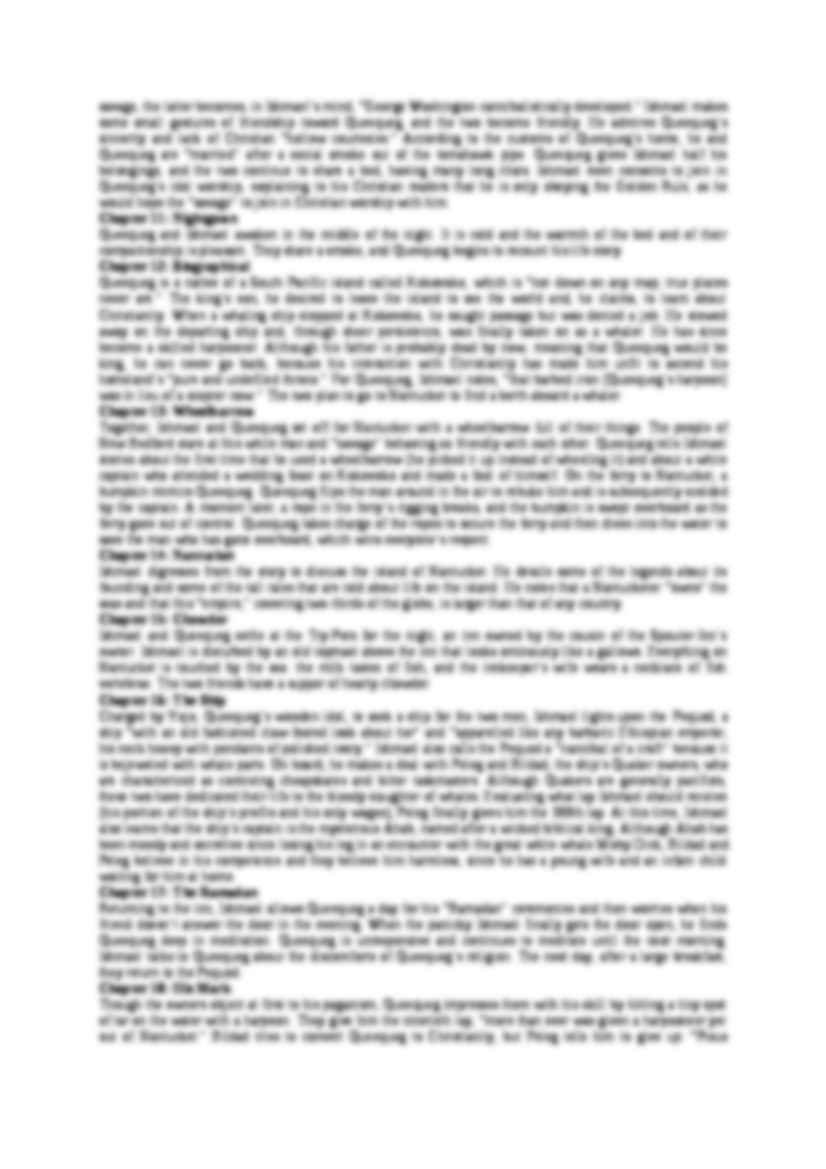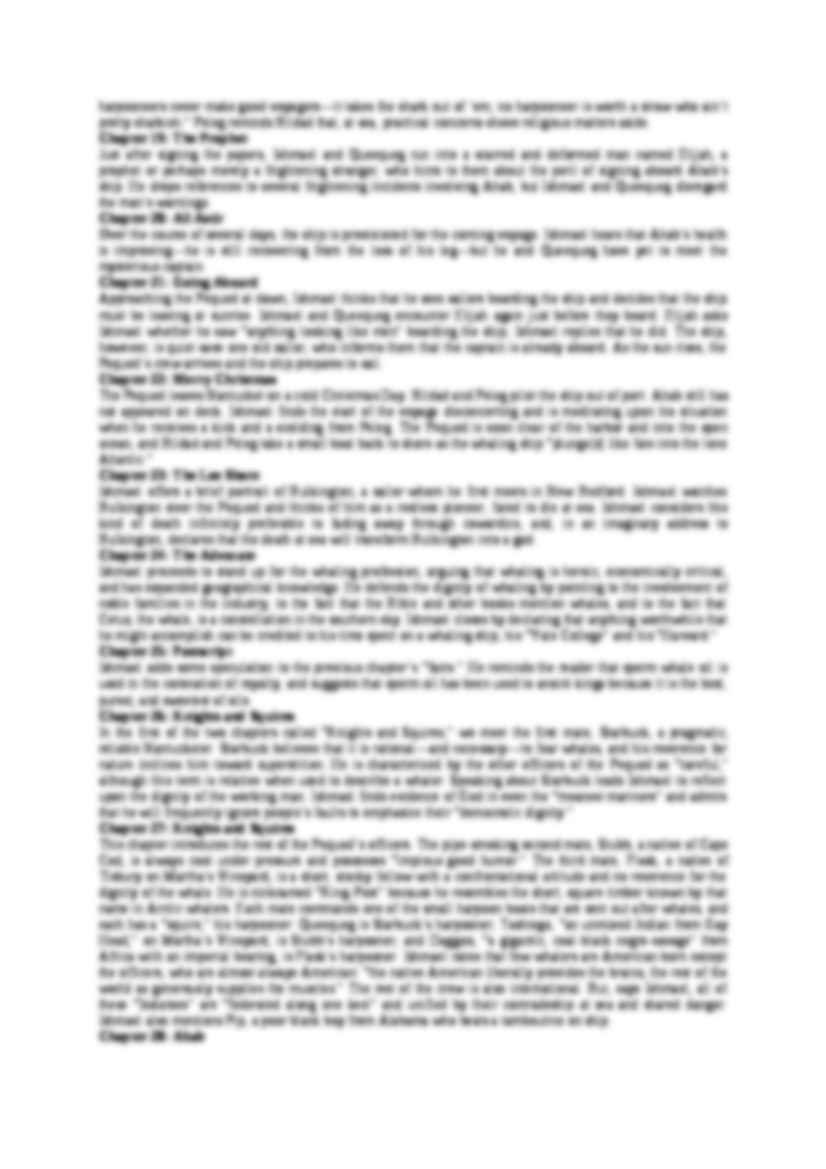


Fragment notatki:
Chapter 1: Loomings
The narrative of Moby-Dick begins with the famous brief sentence, “Call me Ishmael.” Ishmael, a sailor, describes a typical scene in New York City, with large groups of men gathering on their days off to contemplate the ocean and dream of a life at sea. He explains that he himself went to sea because, like these men, he was feeling a “damp, drizzly November in [his] soul” and craved adventure. Shunning anything too “respectable” (or expensive), he always ships as a common sailor rather than as a passenger.
Chapter 2: The Carpet-Bag
Ishmael travels from New York to New Bedford, Massachusetts, the whaling capital of the United States. He arrives too late to catch the ferry to Nantucket, the original whaling center of New England; for the sake of tradition, Ishmael wants to sail in a Nantucket whaler. For now, however, he has to spend a few nights in New Bedford. He roams the streets looking for an inn, but those that he finds seem too expensive. He stumbles into, then quickly out of, a church full of wailing and weeping African Americans, where a sermon is being preached on “the blackness of darkness.” Ishmael finally wanders into the Spouter-Inn, owned by Peter Coffin. The ominous name of the inn and the owner satisfy his mood, and the place is dilapidated and sure to be cheap.
Chapter 3: The Spouter-Inn
Inside the Spouter-Inn, Ishmael finds a large, somewhat inscrutable oil painting, which he finally determines to be a depiction of a whale attacking a ship. On the other wall is a collection of “monstrous clubs and spears.” Because the inn is nearly full, Ishmael learns that he will have to share a room with “a dark complexioned” harpooner named Queequeg. He passes the evening in the bar with “a wild set of mariners,” waiting for Queequeg to arrive. Out of apprehension, Ishmael decides that he would rather sleep on a bench than share a bed with some strange, possibly dangerous man. The bench is too uncomfortable, though, and Ishmael decides to put up with the unknown harpooner, who, Coffin had assured him, is perfectly fine because “he pays reg'lar.” Still, Ishmael is worried, since Coffin adds that the harpooner has recently arrived from the South Seas and is currently out peddling shrunken heads. When Queequeg finally returns, the frightened Ishmael watches him from the bed, noting with horror the harpooner's tattoos and tomahawk pipe. Queequeg sets up and worships a small, dark-colored idol. His prayers over, he discovers Ishmael in his bed. He flourishes the tomahawk pipe as Ishmael shouts for the inn's owner. After Coffin explains the situation, Ishmael and Queequeg settle in for the night, Ishmael having decided that it is better to share a bed with a “sober cannibal” than a “drunken Christian.”
Chapter 4: The Counterpane
When Queequeg and Ishmael wake up the next morning, Queequeg's arm lies affectionately thrown over Ishmael, as if the latter were “his wife.” Ishmael watches the cannibal don a fancy hat and boots and shave himself with his harpoon. He marvels at the “savage's understanding of civilized manners.
(…)
… notes that a Nantucketer “owns” the seas and that this “empire,” covering two-thirds of the globe, is larger than that of any country.
Chapter 15: Chowder
Ishmael and Queequeg settle at the Try-Pots for the night, an inn owned by the cousin of the Spouter-Inn's owner. Ishmael is disturbed by an old topmast above the inn that looks ominously like a gallows. Everything on Nantucket is touched by the sea…
… harmless, since he has a young wife and an infant child waiting for him at home.
Chapter 17: The Ramadan
Returning to the inn, Ishmael allows Queequeg a day for his “Ramadan” ceremonies and then worries when his friend doesn't answer the door in the evening. When the panicky Ishmael finally gets the door open, he finds Queequeg deep in meditation. Queequeg is unresponsive and continues to meditate until…
…. Just as the men are about to push off in the harpoon boats, “five dusky phantoms” emerge around Ahab.
Chapter 48: The First Lowering
As the crew launches the harpoon boats for the first time this voyage, Ahab's secret crew emerges from the hold and boards the captain's harpoon boat. Fedallah, their leader, is a dark, sinister figure with a Chinese jacket and a turban made from coiling his own hair…
… to bolster his credibility in describing the whale, he tells of a visit to his friend Tranquo, king of Tranque (apparently a fictional place). In Tranque, a large sperm whale skeleton is used as a temple, with its skull as an altar. Although the priests protested, claiming that it is impossible to measure God, Ishmael took the whale's dimensions and had them tattooed on his right arm. He had the dimensions recorded in short form because he wished to save as much space on his body as possible for “a blank page for a poem [he] was then composing.”
Chapter 103: Measurement of the Whale's Skeleton
Ishmael offers his findings, based on the skeleton of the whale that he measured in Tranque. He believes that the largest sperm whales are around ninety tons, and “would considerably outweigh the combined population…
… up to the main royal-mast, Ahab spots Moby Dick and earns himself the doubloon. All of the boats set off in chase of the whale. When Moby Dick finally surfaces, he does so directly beneath Ahab's boat, destroying it and casting its crew into the water. The whale threatens the men, but the Pequod, with Starbuck at the helm, drives it away, and the men are rescued by the other boats. The whale then…
... zobacz całą notatkę

Komentarze użytkowników (0)